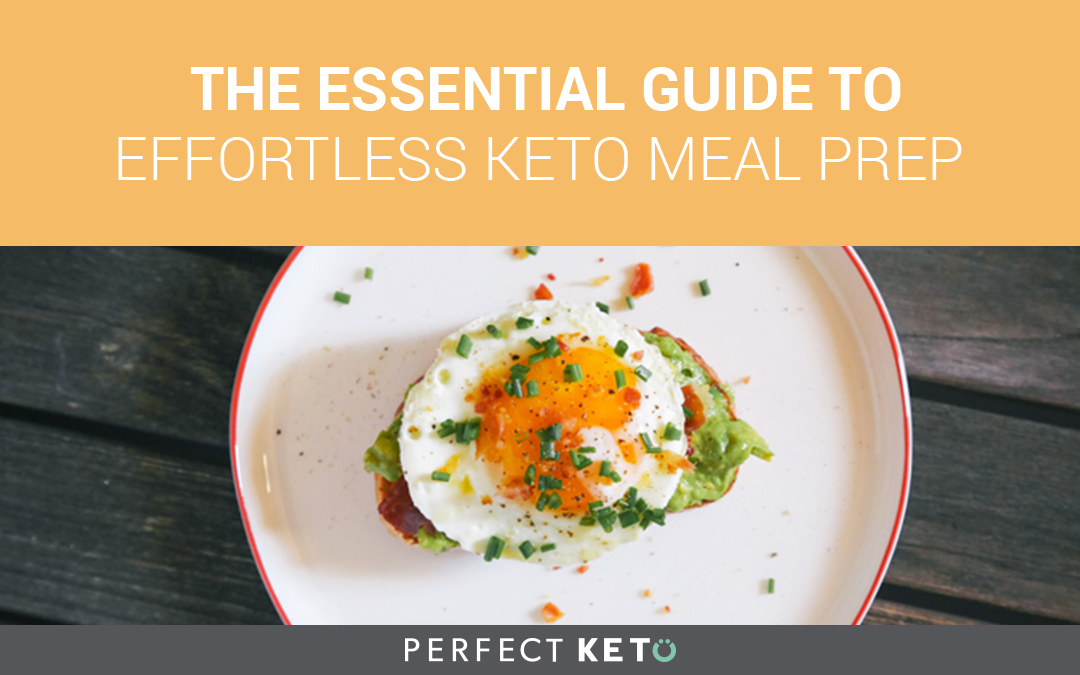Keto Meal Prep: Mastering the ketogenic diet requires dedication, but strategic meal preparation can transform this demanding lifestyle into a manageable and enjoyable experience. This guide delves into the core principles of ketogenic dieting, offering practical advice, delicious recipes, and time-saving strategies to help you achieve your health and wellness goals.
From crafting comprehensive shopping lists and mastering efficient cooking techniques to understanding optimal storage and reheating methods, we cover every aspect of successful keto meal prepping. We’ll explore diverse recipes, address common challenges, and provide customizable solutions to fit individual needs and preferences, ensuring a sustainable and satisfying keto journey.
Keto Meal Prep: A Comprehensive Guide
The ketogenic diet, characterized by its high-fat, moderate-protein, and very-low-carbohydrate intake, has gained significant popularity for its potential weight-loss benefits and improved metabolic health. Effectively managing this diet often requires meticulous planning and preparation. Keto meal prepping streamlines this process, ensuring consistent adherence and maximizing the diet’s advantages.
Defining Keto Meal Prep
Keto meal prep involves planning and preparing ketogenic meals in advance. This proactive approach simplifies daily meal choices, reduces the temptation to stray from the diet, and saves valuable time. The core principle of the ketogenic diet is to induce a metabolic state called ketosis, where the body primarily burns fat for energy instead of carbohydrates. This shift in energy source leads to potential weight loss, increased energy levels, and improved blood sugar control.
Meal prepping for keto significantly enhances adherence by eliminating last-minute decisions and ensuring consistent macronutrient intake.
Common challenges include maintaining variety to avoid dietary boredom and managing the time commitment. Solutions include creating diverse recipes, utilizing batch cooking techniques, and strategically planning weekly meal schedules. Failure to properly store meals can lead to spoilage and compromise food safety, necessitating adherence to proper storage techniques.
A sample weekly keto meal plan might include:
- Monday: Salmon with asparagus and avocado.
- Tuesday: Chicken salad with celery and mayonnaise, served in lettuce cups.
- Wednesday: Steak with cauliflower mash and green beans.
- Thursday: Leftovers from Wednesday.
- Friday: Ground beef and zucchini stir-fry.
- Saturday: Omelette with cheese and spinach.
- Sunday: Pork chops with roasted Brussels sprouts and a side salad.
Essential Keto Ingredients & Shopping Lists
A successful keto meal prep relies on stocking your pantry and refrigerator with the right ingredients. This section Artikels essential keto-friendly ingredients and provides a sample shopping list for a week’s worth of meals.
A typical shopping list might include:
- Various meats (beef, chicken, pork, fish)
- Fatty fish (salmon, mackerel)
- Eggs
- Avocados
- Nuts and seeds
- Healthy fats (olive oil, coconut oil, avocado oil)
- Low-carb vegetables (broccoli, cauliflower, spinach, asparagus)
- Cheese
- Full-fat coconut milk
- Unsweetened almond milk
- Chia seeds
- Flax seeds
An infographic would visually represent this list, using bullet points and categorized sections for easy reference. Buying ingredients in bulk can often be more cost-effective, especially for frequently used items like olive oil or nuts, but requires careful consideration of storage space and potential spoilage.
Keto Meal Prep Recipes & Techniques

Source: perfectketo.com
This section provides three diverse keto-friendly recipes, highlighting simple and quick cooking techniques. Adaptations for vegetarian keto diets are also considered.
Recipe 1: Keto Breakfast – Coconut Flour Pancakes: These pancakes use coconut flour for a low-carb base and are cooked quickly in a pan.
Recipe 2: Keto Lunch – Chicken Salad Lettuce Wraps: A simple and refreshing lunch option, utilizing leftover cooked chicken.
Recipe 3: Keto Dinner – One-Pan Roasted Salmon and Asparagus: A healthy and easy dinner that requires minimal cleanup.
These recipes can be adapted to accommodate various dietary needs or preferences. For instance, the chicken salad can easily incorporate different vegetables or herbs. The salmon and asparagus dish can substitute other vegetables like broccoli or green beans. Vegetarian adaptations might replace the chicken with tofu or tempeh in the salad.
| Recipe | Calories | Fat (g) | Protein (g) | Net Carbs (g) |
|---|---|---|---|---|
| Coconut Flour Pancakes | 250 | 18 | 8 | 5 |
| Chicken Salad Lettuce Wraps | 300 | 20 | 25 | 3 |
| One-Pan Roasted Salmon and Asparagus | 400 | 30 | 30 | 5 |
Storage & Reheating Keto Meals
Proper storage and reheating are crucial for maintaining the quality and safety of prepared keto meals. This section addresses optimal methods and potential issues.
Keto meal prep is gaining popularity for its convenience and effectiveness in weight management. The meticulous planning involved mirrors the dedication required in other lifestyle choices, such as considering whether practices like those discussed in the article, is salish matter adopted in real life , are successfully implemented. Ultimately, both keto meal prep and adopting new lifestyle changes demand commitment and careful consideration for long-term success.
Optimal storage methods involve using airtight containers, storing meals properly refrigerated, and consuming within a reasonable timeframe (3-4 days). Reheating methods should minimize moisture loss and prevent nutrient degradation. Certain keto ingredients, like leafy greens, may wilt upon reheating; therefore, adding them fresh after reheating is recommended.
- Use glass or BPA-free plastic containers.
- Label containers with the meal name and date.
- Reheat gently in the microwave or oven.
- Avoid over-reheating, which can negatively impact texture and flavor.
Time-Saving Keto Meal Prep Strategies
Efficient keto meal prep requires strategic planning and the utilization of time-saving techniques. Batch cooking and advance ingredient preparation are key strategies.
Batch cooking involves preparing large quantities of ingredients or dishes at once. Examples include roasting a large batch of vegetables or cooking a large quantity of chicken breast. Prepping ingredients in advance, such as chopping vegetables or cooking grains, streamlines meal assembly during the week. A weekly schedule might allocate specific time blocks for grocery shopping, cooking, and packaging meals.
- Sunday: Grocery shopping and large-scale cooking (e.g., roasting vegetables, cooking chicken).
- Monday-Friday: Quick assembly of meals from prepped ingredients.
Variations & Customization of Keto Meal Prep
Keto meal prep can be adapted to accommodate individual caloric needs and activity levels. This involves adjusting portion sizes and incorporating a variety of keto-friendly snacks.
Seasonal ingredients can enhance the variety and flavor of keto meals. Examples include using summer squash in the summer months and incorporating root vegetables during the fall and winter. The visual appeal of meals can be enhanced through the use of attractive containers and careful plating.
A visual guide might showcase different container options, highlighting their suitability for various meal types (e.g., salads, soups, entrees).
Summary: Keto Meal Prep

Source: redd.it
Embarking on a ketogenic diet doesn’t have to be daunting. By embracing the principles of strategic keto meal prep, you can streamline your approach to healthy eating, ensuring consistent adherence to your dietary plan. This guide provides the tools and knowledge necessary to transform keto from a restrictive diet into a delicious and manageable lifestyle choice, unlocking the potential for long-term success and improved well-being.
